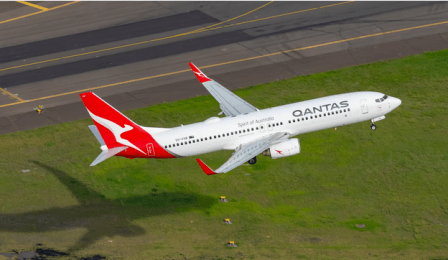Australia’s Transportation Safety Bureau (ATSB) highlighted the crew of Qantas flight QF-144’s “effective decision making” within its final report into the January 2023 engine shutdown.
Published on Friday, the ATSB noted the flight crew’s decision not to divert to nearby Norfolk Island Airport (NLK) in favor of continuing onto Sydney’s Kingsford Smith Airport (SYD) prevented additional risk to the stressful situation, allowing for the crew to perform a successful single engine landing at the airport.
While en route from Auckland Airport (AKL) to Sydney on January 18, the flight crew of QF-144 noted a pop sound prior to the autopilot and autothrottle disengaging. The Boeing 737-800’s left CFM International CFM56-7B engine was stated not to be operating. Cabin crew members and passengers reported a similar loud bang and yaw coinciding with the shutdown, described as “not normal” to the ATSB by the flight’s cabin safety manager.
After declaring MAYDAY, the crew carried onto Sydney amid poorer operational conditions and limited emergency response options at the closest diversion airport, Norfolk Island.
The aircraft continued to operate safely on one engine as the crew worked through its checklists. However, the cabin safety manager noted several related incidents, such as the increased temperature in the cabin and limited power across the galley and rear bathrooms. Conditions were subsequently primarily solved by the flight crew adjusting the temperature controller.
Despite unsuccessfully attempting to restart the engine, the call was downgraded to a PAN PAN before arrival in Sydney, though the crew requested emergency services upon arrival as a precaution. QF-144 landed safely and uneventfully at the airport at 15:26 AEDT, just over an hour after the emergency was declared, with no injuries reported.
The ten-year-old 737 operating the flight, VH-XZB, remained grounded at Syndey for six days following the incident, allowing for ATSB investigators to download the “quarantined” data from the Flight Data Recorder (FDR) and Cockpit Voice Recorder (CVR). VH-XZB returned to service on January 26.
During the ATSB investigation, it was found that the CVR had been inadvertently overwritten by maintenance crews, preventing direct evidence on the flight crew’s management and decision-making during the flight; however, the ATSB found the handling of the incident was consistent with relevant testimonies, adding that “The Trans-Tasman engine failure event highlights benefits of effective decision making.”
“The flight crew’s decision to continue to Sydney ensured no additional risk was added to an already high workload situation.”
Several probable causes of the incident were highlighted; the separation of the radial driveshaft affecting the engine core and accessory gearbox, causing a loss of fuel pump pressure, and a failed driveshaft preventing the crew from restarting the engine.
Qantas briefly came under fire following the January incident, which followed two similar engine-related issues on another 737 and 717 across a three-day period.
In a statement shared in January, Qantas Domestic CEO Andrew David reaffirmed the carrier’s commitment to safety, emphasizing the need to put the incidents into context.
“Aircraft are complex pieces of machinery with millions of moving parts, and it’s not uncommon to have a problem with one of them. What’s important to know is that aircraft are designed with that in mind and have a lot of built-in redundancy, and our crews are trained to deal with those situations so that they can land safely”.
Engine shutdowns are relatively uncommon events, with CFM International citing in a 2004 blog post that the CFM56-7B engine’s shutdown rate is around 0.002, or one flight every 500,000 flight hours.
Qantas has been approached for comment.
Sources: Simple Flying, The Aviation Herald, CFM International

